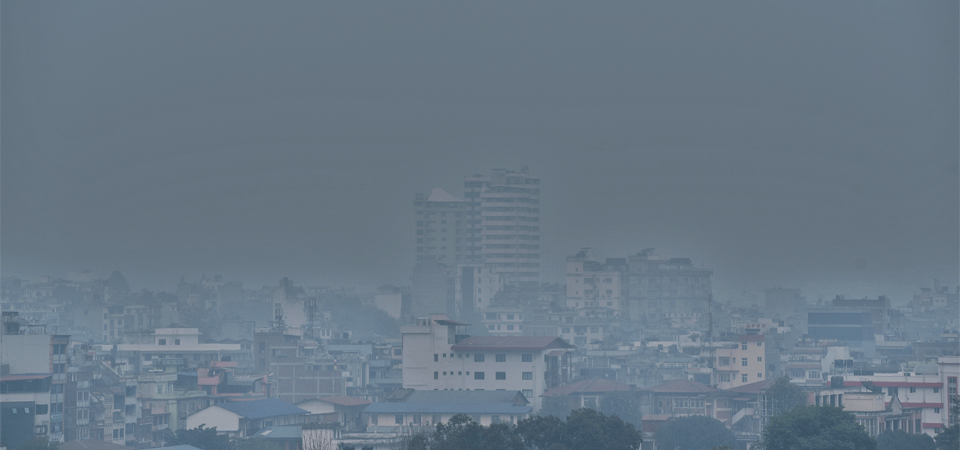Air pollution increases again

By A Staff Reporter
Kathmandu, Apr. 6: Air pollution has shot up across the country again from Sunday.
“Rainfall on Wednesday last week in eastern and central Nepal had helped reduce the air pollution level, but the situation has started deteriorating again since Sunday ,” Indu Bikram Joshi, deputy director general and spokesperson at Department of Environment, said.
According to Joshi, the Air Quality Index (AQI) of AQI station of Phohara Durbar near Kantipath has shown AQI at 313 in the last 24 hours, 290 in Maharajgunj and 158 in Ratna Park.
According to Joshi, the highest level of air pollution was measured in Dhangadhi on Monday morning. Dhangadhi’s AQI reached 429 this morning. Bharatpur of Chitwan is in second position with AQI 398, followed by Bhainsepati in Lalitpur at 325. However, when measured every hour, Bhainsepati’s AQI is not more than 190, said Joshi.
An AQI of 50 is considered healthy, 50 to 100 is considered as moderate. When the AQI reaches 150, it will become unhealthy to certain sensitive age groups.
Reaching 200 is unhealthy for everyone. AQI 300 is considered risky and above 300 is considered fatal or most hazardous.
Nirmal Chaudhary, environmentalist and environment inspector at Department of Environment, said continuous dry winter, forest fires across of the country, weak westerly winds, and smog have increased air pollution. Owing to gaseous air pollution, the government had closed schools across the country last week.
Chaudhary suggested avoiding air pollution, using masks as much as possible, and taking special care of children and the elderly to escape its impact.
Senior meteorologist Min Kumar Aryal said during pre-monsoon season, westerly winds enter Nepal through Jammu and Kashmir. This wind causes snow in the mountains, rain in the hills and lowlands. During pre-monsoon, local air also gets activated and rain is expected in certain places. But this time, all these situations have not been developed yet, said Aryal.
“Not a single strong system has come from the West since October last year. It rained lightly once or twice, but the wind did not bring enough ‘moisture’ to cause rain all over the country at once,” said Pratibha Tuladhar, a meteorologist at the Meteorological Department. There is still no indication of a strong system coming from the West.
According to the statistics of the Division, the Kathmandu Valley receives an average of 45 millimetres of rain from November 3 to March 4. This time only 4 mm of rain has occurred during the period, which means the Kathmandu Valley did not receive even 10 per cent rain this winter. This is a big change in itself, she said.
It is estimated that an average rainfall of 60 mm occurs in Nepal from November 16 to March 15. This time only 16 mm rain occurred across the country.
Tuladhar said not only Nepal, but also the Hindu Kush region from Bhutan to northern India and Pakistan, received less rain this winter.
Meanwhile, air services were affected on the routes of Nepalgunj, Surkhet, and Humla because of haze.
Manager of the Civil Aviation Authority Simkot branch Mohan Giri said that no flight was possible Monday morning due to haze at Nepalganj and Surkhet and Simkot airports.
He said the flight could not take place in the morning because of poor visibility, which was only 3 km in the airport areas. There should be at least 5 km visibility to land and take off an aircraft.
He said that even though the haze in Nepalgunj was cleared after 2 pm, no flight could be operated due to wind in Simkot.
In lack of flights, many passengers were stranded in Nepalgunj, Surkhet and Simkot.
Tara, Sita, Summit, and Nepal Airlines have been operating 15 to 20 flights a day.
Recent News

Do not make expressions casting dout on election: EC
14 Apr, 2022
CM Bhatta says may New Year 2079 BS inspire positive thinking
14 Apr, 2022
Three new cases, 44 recoveries in 24 hours
14 Apr, 2022
689 climbers of 84 teams so far acquire permits for climbing various peaks this spring season
14 Apr, 2022
How the rising cost of living crisis is impacting Nepal
14 Apr, 2022
US military confirms an interstellar meteor collided with Earth
14 Apr, 2022
Valneva Covid vaccine approved for use in UK
14 Apr, 2022
Chair Prachanda highlights need of unity among Maoist, Communist forces
14 Apr, 2022
Ranbir Kapoor and Alia Bhatt: Bollywood toasts star couple on wedding
14 Apr, 2022
President Bhandari confers decorations (Photo Feature)
14 Apr, 2022










